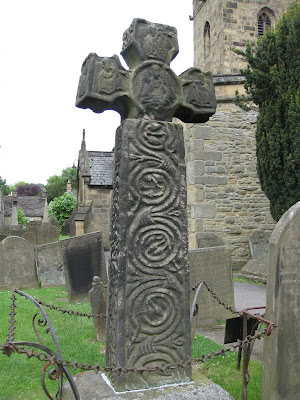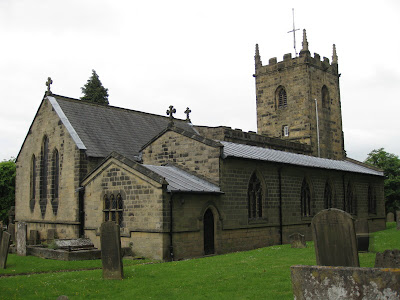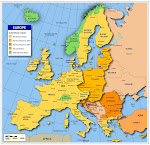June 7
We’re here in the Peaks District, a beautiful, natural area of parkland stretching for miles. We found a campground, Bakewell Camping and Caravanning, Hopping Lane, Youlgreave, Bakewell, Derbyshire. How do you like that for an address? Bakewell is about 10 miles away, by the way. Impossible to find, mind you, but there sure are a lot of names. It’s only £8.40 per night (€9.82), a real deal. Why, you ask? Could it be because there are no toilets, showers, dish washing, sinks or facilities of any kind? I failed to read the fine print about this until last night when it was too late to call and cancel. I called this morning after locating another, more suitable place, making sure they had an opening. Alas, we were told we would lose our £25 deposit unless we cancel 7 days in advance. We decided to grin and bear it, especially after the guy assured us we would love the place. The good news is, we are also in “Low Season,” officially from June 6-July 22.
Youlgreave

Peaks District—View from Homer

Campground

He’s right, in a way. It’s a lovely place. If we really wanted to, we could drag all the junk we have stored in the shower and do some kind of cat bath in there. However, the other inconvenience is that again, we cannot get a signal to use our internet dongle. There are no mountains around, just rolling hills, so I’m puzzled once again by this situation. Perhaps we’re in another saucer dip. We do find our neighbors rather amusing; this guy, who we think is Newt Gingrich, is putting up a short fence to mark his territory and hide his bar-b-que.

These people use their half fence to go bottomless, we assume.

We are here for two reasons: to rest up and relax, and to visit the Plague Village, Eyam (pronounced Eem), which means “Village by the Water.” I read about it in a book by Geraldine Brooks, Year of Wonders, recommended by my exceptional friend and hiking partner, Connie. I loved the book, did a little research and found the village. It’s historical fiction about the Bubonic Plague in 1665-66 and how Eyam decided to quarantine their village to stop the spread of the Plague to other villages.
We’ve been checking every used bookstore we come across for the last few days hoping to find a copy so that Chuck can read it. For some reason, the Kindle price is $12.99 and we just refuse to pay that price (brand new, best sellers go for $9.99). This book was published in 2001. The funny thing is, we’ve met only one person who had heard of the book and that was the Warden at our last campground. She had read it and loved it. No one else has even heard of Eyam. This was especially amusing to me when I checked into the campground here and the Warden asked if we were going to see Haddon Hall. I told him I hadn’t heard of it. His eyes bulged in shock as he listed all the movies that had been filmed there. He was astonished that I didn’t know it. I told him we were here to visit Eyam and he just looked puzzled. “Never heard of it.” I told him it was the Plague Village. Nothing. It’s only about 8 miles from here. I thought he should have been impressed that with the help of two maps and a GPS we found our way here all by ourselves.
Our next door neighbors spent considerable time adjusting and positioning their satellite dish. It squealed in various pitches, much like a hearing test. Can’t miss those TV shows. But how can I make fun when I’m worrying about the lack of a shower? I’ll probably just use the kitchen sink.

We found the tiny village of Eyam with no trouble. We also found a large parking area and a map with the history of the town and descriptions of the various cottages. Late in August 1665, a parcel of cloth arrived from London and was delivered to the local tailor, George Viccars. During that summer there was an epidemic of the Plague in London where more than 100,000 had died. When George saw that the cloth was damp, he put it in front of the fire to dry; this, unfortunately, brought the fleas out of a dormant state. Just two days later he developed a fever. Swellings and a rose-red rash covered his body and on September 7, 1665, George died. The Plague had come to Eyam. Within 6 weeks two more people from that same house died from the Plague and their neighbors became unwell. Fear then spread throughout the village and a few people packed and fled. The Rector, William Mompesson, together with his predecessor, Thomas Stanley, called the villagers together and persuaded them to stay inside the village boundary and so stop the disease from spreading to the rest of Derbyshire. In doing this, they knew that they would probably catch the Plague and die.


Mompesson, helped by the Earl of Devonshire, arranged for supplies of food and other goods needed by the villagers to be left at the Boundary Stone and at what is now called Mompesson’s Well, the southern and northern boundaries of the quarantined area. Money payments for these provisions were “disinfected” by placing the coins in running water or into vinegar.
We decided to walk to the well to see it for ourselves. We stepped around the tufts of wool sheddings and sheep shit dotting the field.


Naturally, we got lost as we tramped along through a field. Suddenly we heard a man calling out and realized he was talking to us. He told us we would not be able to get out the way we were going and directed us over to a wall where we found a Kissing Gate. When we reached the road, his friend Billy was waiting for us with his bike and walked us to the next turn where we could find the well. Billy told us he was in his seventies and rides a 12 mile loop every weekend. He was seeing his tax man today and was so friendly and helpful, something we have found throughout England.
Billy

Mompesson's Well

View of Eyam

Back in the village, we stopped at several of the Plague houses. I was especially excited to see this one, named for my wonderful friend Merlyn.

Merlyn Cottage

This is Plague House, where George Viccars, the first Plague victim, died. He was living with Mary Hadfield and her family. Mary alone survived but lost 13 relatives.
Plague Cottage

This is the Bagshaw House, home of the Siddall family, John and Elizabeth, and their 7 children. Six of the children and John died. She remarried but her second husband died and she followed 3 months later. Joseph Siddall, aged 3, survived.
Bagshaw House

We made our way to the Eyam Parish Church with its 8th century Celtic cross.


Rectory


The church had a nice display with more information. One story really touched us both:
“Emmott Sydall, a girl from Eyam, had for sometime been courting Roland Torre from Stoney Middleton. When Eyam was closed off, the sweethearts continued to meet secretly in the Delf. As the months wore on, 6 out of 8 in Emmott’s family died of the Plague. In fear, she begged Roland to stay away. They were never to meet again for on April 29, 1666, she too perished. When Roland entered Eyam after the Plague, he was given the sad news of her death. He lived to an old age and never married.”
I wondered how far Roland’s village of Stoney Middleton was from Eyam. Later on when we left, we found it just down the hill, perhaps half a mile away.
As the villagers began to realize the full seriousness of their plight, they became frightened to gather together, even for Sunday worship. Mompesson then closed the church and held open air services at the Delf.

Reverend Mompesson was considered a hero; his wife deserves credit as well for staying by his side:
“As the Plague tightened its grip on Eyam, Mompesson begged his wife and children to leave the village. But Catherine would not leave her husband. She sent her children away and remained behind assisting William in comforting the sick and bereaved. One evening, whilst out on a stroll with William, she commented upon the sweetness of the air. William’s heart sank for in his wife’s remark he recognized an early symptom of the Plague. Within a couple of days, Catherine had died. He was heartbroken. In a touching letter to his children, his grief seems insurmountable. He is, however, assured of his wife’s place in heaven. In a letter to his patron, Sir George Saville, he further extols her virtues. To avoid Plague contamination via the paper, the letter was written by the vicar of Heathersage, John Walker, and probably dictated near to Mompesson’s Well.”
We found her tomb in the church cemetery; she was one of the last to die.
Catherine Mompesson’s tomb

Did you know that the nursery rhyme “Ring Around the Rosie” is a reminder of the Plague? This is the English version:
Ring a ring of roses,
A pocket full of posies
Atishoo, atishoo,
We all fall down.
The ring of roses refers to the body rash; the pocket full of posies were the herbs carried to ward off the disease. The sneezing was a symptom of the Plague which, when caught, would lead to falling down DEAD.
We left the church and strolled down the lane to the village, really just a few buildings on Church Street, coming to a small herb garden to sample. This one was interesting:

We found the perfect place for lunch, Peak Pantry. I’ve never seen so many choices of food and desserts. We started with tea.


I couldn’t resist homemade broccoli soup with just the right amount of Stilton cheese melting on top and Chuck had to try a steak, potato and Stilton cheese pasty. DELICIOUS!


We picked up a few things at the tiny grocery then headed to Bakewell where we had spotted a used book store on our way this morning. It was market day and the place was bustling but the Park-and-Pay guy let us park in a non-parking spot marked with orange cones. We walked across a pretty bridge over a river and right to the bookstore where, much to our delight, we found a copy of the book for only £2.10. The bookstore owner had read the book and raved about it. Chuck is already well into it and I plan to read it again as soon as I can wrestle it away from him.

Bookstore over the bridge

Some of the towns we’ve passed through include: Stoke-on-Trent, Sparrowpit, Miller’s Dale, Wormhill, Little Hucklow, Shirley, Rodsley, Snelston, Little Cubley and Great Cubley. We are looking forward with great anticipation to Berwick-upon-Tweed.
Greater love has no-one than this; that he lay down his life for his friends. ~ John 15:3


3 comments:
Fascinating blog. Thanks for sharing what you've learned about the plague. I didn't know about the nursery rhyme's connection to the plague. I wonder how it became a nursery rhyme? Loved the rat weather vane! Can't stand rats, but thought the weather vane was cute. Glad you guys are back on line. I was beginning to wonder.
Carol
Wow. That was moving. Thank goodness you bring us back to the here-&-now with another culinary delight!
Just goes to show that in spite of the horrors humans have invented, love for one's fellow man runs deep in the genetic code ~ or soul?
Onward to your next adventure in jolly olde England...
Hi Claire,
I read "The Year of Wonders." It never occurred to me to look for the village while we were living in the UK.
I see that Chuck was able to have mushy peas with his pasty. It seems so strange to me that an over-cooked mistake like that could be comfort food.
Thanks so much for sharing your adventures.
Marilyn
Post a Comment